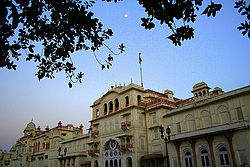Patiala is a city in southeastern Punjab, northwestern India. It is the fourth largest city in the state and is the administrative capital of Patiala district. Patiala is located around the Qila Mubarak (the Fortunate Castle). It was constructed by chieftain 'Baba Ala Singh', who founded the royal dynasty of the Patiala State in 1763.
In popular culture, the city remains famous for its traditional PatialaShahi turban (a type of headgear), paranda (a tasselled tag for braiding hair), patiala salwar (a type of female trousers), jutti (a type of footwear) and Patiala peg (a measure of liquor).
History

Patiala state was established in 1763 by Baba Ala Singh, a Jat Sikh chieftain, who laid the foundation of the Patiala
fort known as Qila Mubarak, around 'which the present city of Patiala is built. After the Third Battle of Panipat in
1761 in which the Marathas were defeated by the Afghans, the writ of the Afghans prevailed throughout Punjab. It is at
this stage that the rulers of Patiala began to acquire ensigns of royalty. The Patiala state saw more than forty years
of ceaseless power struggle with the Afghan Durrani Empire, Maratha Empire and the Sikh Empire of Lahore. In 1808, the
Raja of Patiala entered into a treaty with the British against Ranjit Singh of Lahore in 1808, thus becoming
collaborator in the grand empire building process by the British in, the sub-continent of India. Patiala became a 17-guns
salute state during the British Raj. The rulers of Patiala such as Karam Singh, Narinder Singh, Mahendra Singh, Rajinder
Singh, Bhupinder Singh and Yadvindra Singh were treated with respect and dignity by the British.
The city of Patiala was designed and developed according to a plan akin to that of temple architecture, the first
settlers of Patiala were the Hindus of Sirhind, who opened their business establishments outside the Darshani Gate.
Hinduism and Sikhism are the prominent religions of Patiala City. Minorities are Muslims, Christians, Jains and Buddhists.
Patiala's sway over the Malwa area extended beyond merely political influence. Patiala was equally the set of religious
and cultural life. Educationally, Patiala was in the forefront. Patiala was the first town in this part of the country
to have a degree college – the Mohindra College – in 1870.
Patiala has one of the highest number of vehicles per capita in India.
Shri Kali Devi Temple is a Hindu temple dedicated to Maa Kaali. The temple was built by the Sikh ruler of the Patiala
State, Maharaja Bhupinder Singh, who financed the building of the temple in his capital and oversaw its installation in
1936. Legend has it that the Maharajah built the temple to protect the city from flooding and performed annual sacrifice
at the temple.. Bhupinder Singh ruled the princely state of Patiala from 1900 to 1938. He brought the 6-ft statue of
Divine Mother Kali and Paawan Jyoti from Bengal to Patiala and offered the first Bali (sacrifice) of a water buffalo to
the temple. Because of the temple’s beautiful structure, it has been declared a national monument. This large complex
attracts devotees, Hindu and Sikh, from distant places. A much older temple of Raj Rajeshwari is also situated in the
centre of this complex. The temple is situated opposite the Baradari garden at Mall Road. Devotees offer mustard oil,
daal (lentils), sweets, coconuts, bangles and chunnis, goats, hens and liquor to the Divine Mother here. As an average
estimate, devotees offer more than 60,000 liquor bottles during Navratras alone, which goes into a 'Sharab Kund' built on
the temple's premises.
According to local tradition, supported by an old handwritten document preserved in the Gurdwara, one Bhag Ram, a jhivar
of Lehal, waited upon ninth guru of Sikhs Guru Tegh Bahadur during his sojourn at Saifabad (now Bahadurgarh), and made
the request that he might be pleased to visit and bless his village so that its inhabitants could be rid of a serious and
mysterious sickness which had been their bane for a long time. The Guru visited Lehal on Magh sudi 5, 1728
Bikram/24 January 1672 and stayed under a banyan tree by the side of a pond.[1] The sickness in the village subsided.
The site where Guru Tegh Bahadur had sat came to be known as Dukh Nivaran, literally meaning eradicator of suffering.
Devotees have faith in the healing qualities of water in the sarovar attached to the shrine. It is still believed that
any kind of illness can be cured by 'ishnaan' on 5 consecutive panchmi. It is in the vicinity of Patiala Bus Station.
Gurudwara Moti Baag Sahib is situated in the Patiala City. When Shri Guru Teg Bahadur started his journey towards Delhi,
he came here via Kiratpur Sahib, Bharatgarh Sahib, Roap Makar, Kabulpur etc. Saint Saif Ali Khan was great follower of
Guru Sahib, To fulfill his wish Guru Sahib came to his Place Saifabad (Bahadur Garh). Guru Sahib stayed here for 3 Months
. Saif Ali Khan Served Guru Sahib with great Devotion. In daytime Guru Sahib used to meditate on the Place inside the
Qila(Fort) and used to come here in the nighttime. From here Guru Sahib left towards Samana, Guru Sahib took rest for
some time this place. From here Guru Sahib left towards Samana and stayed in the Haveli of Muhamad Bakhsish. From there
onwards Guru Sahib left towards Cheeka Via Karhali, Balbera.
The Bahadurgarh Fort is 6 kilometres away from Patiala city. It is situated on the Patiala-Chandigarh road. The fort was
constructed by mughal Nawab Saif Khan in 1658 A.D where Guru Teg Bahadur visited him and later renovated by a Sikh ruler
Maharaja Karam Singh in 1837. The construction of the entire fort was completed in eight years. A sum of ten lakh rupees
was spent on its construction. It covers an area of 2 km2. The fort is enclosed within two rounded walls and a moat. The
circumference of the fort is slightly over two kilometres.
The Qila Mubarak complex stands on a 10-acre ground in the heart of the city and contains the main palace or Qila Androon
(literally, 'inner fort'), the guesthouse or Ran Baas and the Darbar Hall. Outside the Qila are the Darshani Gate, a Shiva
temple, and bazaar shops which border the streets that run around the Qila and sell precious ornaments, colourful
hand-woven fabrics, 'jootis' and bright 'Parandis'.
A part of the Old Moti Bagh Palace built in the 19th century by the Maharajas is the famous Sheesh Mahal, literally
meaning the Palace of Mirrors. The mahal contains a large number of frescoes, most of which were made under His Highness
Maharaja Narinder Singh. A lake in front of the palace adds to the beauty. Lakshman Jhula, a bridge built across the lake,
is a famous attraction. A museum housing the largest collection of medals from the world collected by His Highness Maharaja
Bhupinder Singh is here.
The Baradari Gardens, the garden with 12 gates, are in the north of old Patiala city, just outside Sheranwala Gate. The
garden complex, set up during the reign of Maharaja Rajindera Singh, has extensive vegetation of rare trees, shrubs, and
flowers dotted with impressive Colonial buildings and a marble statue of Maharaja Rajindera Singh. It was built as a
royal residence with a cricket stadium, a skating rink and a small palace set in its heart named Rajindera Kothi. The
gardens include a museum building with collections of Maharaja Ranjeet Singh.
Founded in 1961, Netaji Subhas National Institute of Sports (NIS) is Asia's largest sports institute in princely city of
Patiala. The institute was renamed as Netaji Subhas National Institute of Sports in January 1973.
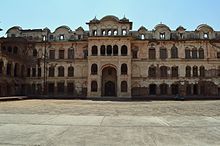
The royal house is now headed by Captain Amarinder Singh who is also the current Chief Minister of Punjab. The royals are
considered cultural and political icons in east Punjab.
Maharaja Karam Singh who ruled from 1813 to 1845 (the Sikh Kingdom of Patiala in Punjab) joined the British East India
Company and helped the British during the First Anglo Sikh wars against the Sikh Empire of Maharajah Ranjit Singh of
Punjab which was larger and extended from Tibet Kashmir, plains of Punjab to Peshawar near the Afghan borders.
Religion
As per provisional data of 2011 census Patiala UA had a population of 446,246 and Patiala city 406,192.Males constituted
54% of the population, and females 46%. Patiala had an average literacy rate of 86%, higher than the national average of
64.9%. In Patiala, 10% of the population was under 5 years of age.
Culture and Traditions

Patiala has seen the evolution of a distinct style of architecture. Borrowing from the Rajput style, its beauty and
elegance are moulded according to the local traditions.
With the active patronage of the Maharajas of Patiala, a well-established style of Hindustani music called the
"Patiala Gharana" came into existence and has held its own up to the present times. This school of music has had a
number of famous musicians, many of whom came to Patiala after the disintegration of the Mughal Court at Delhi in the
18th century. At the turn of the century, Ustad Ali Bux was the most renowned exponent of this Gharana. Later, his sons
Ustad Akhtar Hussain Khan and Ustad Bade Ghulam Ali Khan achieved worldwide fame and brought glory to the Patiala
Gharana.
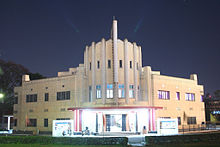
After partition of British India, Muslims were forced to flee the city en masses to Pakistan, while many Hindu and Sikh
refugees migrated from Pakistan and settled on the Muslim properties in Patiala. The then Maharaja of Patiala, His
Highness Yadavindra Singh, Rajpramukh of PEPSU with his wife Her Highness Maharani Mohinder Kaur organised a large number
of camps and worked tirelessly for the people.
Transport
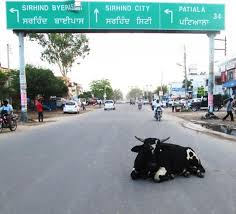
It is connected to cities like Ambala, Chandigarh, Amritsar, Delhi etc. by road. Patiala is well connected to cities like
Ludhiana, Jalandhar and Amritsar, on NH 1 via State Highway no. 8 till Sirhind, which is on NH 1. Patiala is well
connected to Delhi by road as well as by rail. NH 64 (Zirakpur – Patiala – Sangrur – Bhatinda) connects Patiala with
Rajpura (on NH 1 and very well connected to Delhi) and Zirakpur(suburb of Chandigarh). Patiala has a railway station
under Ambala railway division and Patiala Airport, which is not operational. The nearest domestic airport is Chandigarh
Airport, which is approximately 62 km from the city.
Patiala is connected by road to all the major towns.
Tourists Places in Patiala
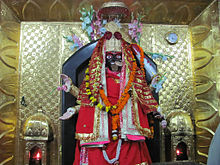
Shri Kali Devi Mandir

Gurudwara Dukh Niwaran Sahib
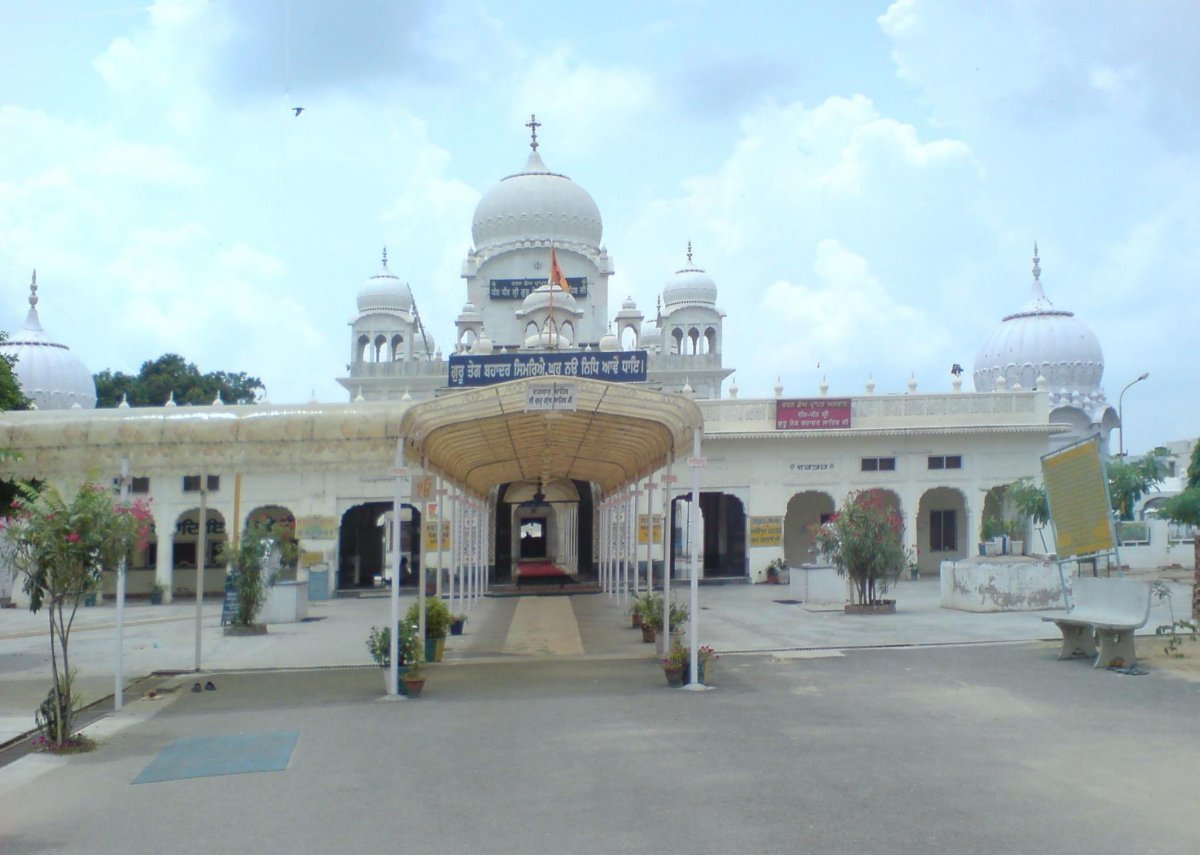
Gurudwara Moti Bagh Sahib

Bahadurgarh Fort
The name Bahadurgarh fort was given by Maharaja Karam Singh as a tribute to the Sikh Guru Teg Bahadur who stayed here for
three months and nine days before leaving for Delhi where he was executed by Aurangzeb in 1675 CE.The fort consists of a
historical Gurdwara Sahib (a Sikh temple) named Gurdwara Sahib Patshai Nauvin.This Gurudwara shows fine Sikh architecture.
This gurudwara is controlled by the Shiromini Gurdwara Prabhandak Committee. People visit this gurdwara on the occasion
of the festival of Baisakhi on 13 April, every year.
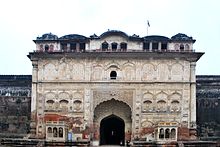
Qila Mubarak Complex
It was the principal residence of the Patiala royals until the construction of Old Moti Bagh Palace.
The entrance is through an imposing gate. The architectural style of the palace is a synthesis of late Mughal and
Rajasthani. The complex has 10 courtyards along the north-south axis. Each courtyard is unique in size and character,
some being broad, others very small and others mere slits in the fabric of building. Though the Androon is a single
interconnected building, it is spoken of as a series of palaces. Each set of rooms makes a cluster around a courtyard,
and each carries a name: Topkhana, Qila Mubarak, Sheesh Mahal, Treasury and Prison. Ten of the rooms are painted with
frescoes or decorated intricately with mirror and gilt.
In a tiny portion of the complex is a little British construction with Gothic arches, fireplaces made of marble and
built-in toilets perched on the Mughal Rajasthani roof. Burj Baba Ala Singh has a fire smoldering ever since the time of
Baba Ala Singh, along with a flame brought by him from Jwalaji. Every year its decorated beautifully for the Heritage
Festival.
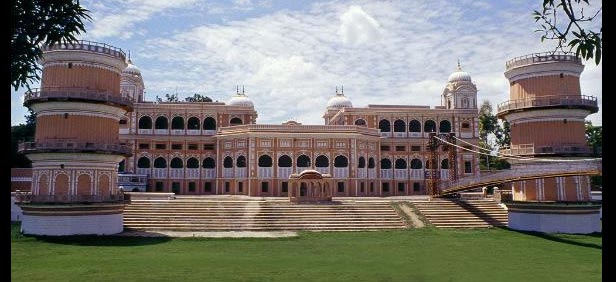
Seesh Mahal
Currently the museum along with the main building is closed for public viewing because of renovation. However, tourists
can access the surroundings of the Mahal along with the Lakshman Jhula.

Baradari Garden
After extensive restoration it opened as a heritage hotel run by Neemrana Hotels group in 2009. It is Punjab's first
heritage hotel. It is near Press Club Patiala. Press Club Patiala was established in 2006 and now headed by Parveen
Komal, president.
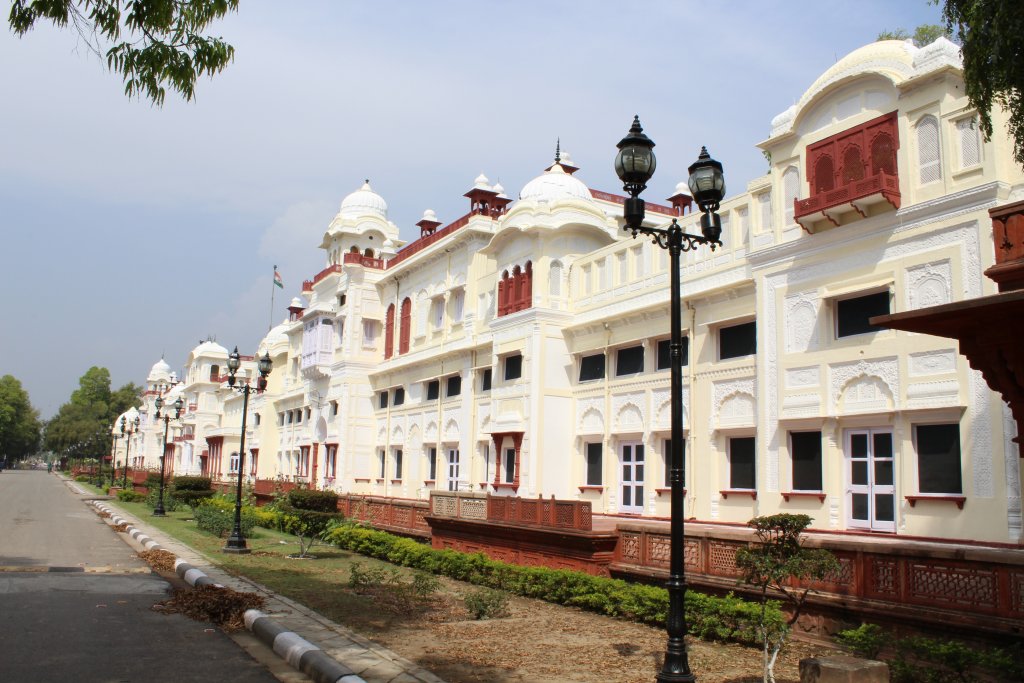
National Institute Of Sports
NIS is housed in the Old Moti Bagh palace of erstwhile royal family of Patiala, which was purchased by government of
India after Indian Independence. Today, several sport memorabilia, like a hass (doughnut shaped exercise disc), weighing
95 kg, used by the Great Gama for squats, Major Dhyan Chand's gold medal, from 1928 Amsterdam Olympics, and PT Usha 1986
Seoul Asiad shoes, are housed at the National Institute of Sports Museum.
